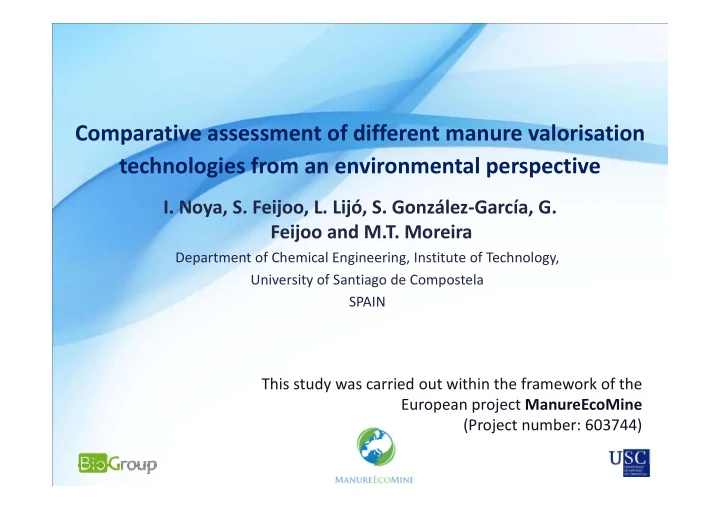

Comparative assessment of different manure valorisation technologies from an environmental perspective I. Noya, S. Feijoo, L. Lijó, S. González ‐ García, G. Feijoo and M.T. Moreira Department of Chemical Engineering, Institute of Technology, University of Santiago de Compostela SPAIN This study was carried out within the framework of the European project ManureEcoMine (Project number: 603744)
Group of Environmental Engineering and Bioprocesses (Biogroup) University of Santiago de Compostela (USC) Nutrient removal using conventional and advanced biological processes Biological systems for wastewater treatment based on granules and biofilms Advanced monitoring and control of wastewater anaerobic treatment Enzymatic degradation of recalcitrant compounds Life Cycle Assessment (LCA) Environmental Risk Analysis
LCA comprehensive evaluation of the environmental consequences that a product or service have on the environment throughout its life cycle. LCA method has been standardized by means of the Figure 1. Life Cycle Assessment perspective. following standards: ISO 14040 (2006): Life Cycle Assessment – Principles and Framework ISO 14044 (2006): Life Cycle Assessment – Requirements and Guidelines
Inventory data collection Inputs from Technosphere Electricity 1000 kWh Outputs to Environment CH 4 60 kg Impact Goal and scope N 2 O 0.1 kg assessment definition Environmental results Impact categories A B C Climate change 10 60 ‐ 1 Acidification 5 15 ‐ 5 Eutrophication 0.8 1 0 Interpretation - Conclusions - Recommendations - Improvement options
Sources of pollution: • Manure storage • Transport • Manure application to land Nitrates Directive (91/676/CEE) CH 4 CO 2 N 2 O NH 3 N 2 O NH 3 NO 3 - PO 4 -3 Production Storage Land application Transport
Biogas production from manure: • Renewable energy production • Lower greenhouse gas emissions • Fertilisation value (avoiding mineral fertilisers) • Less nuisance from odours and flies • Economical advantages for the farmers Bioenergy Electricity production AD CH 4 CO 2 N 2 O NH 3 Transport Production N 2 O NH 3 NO 3 - Storage Land application PO 4 -3
GOAL • Comparative environmental assessment of the impacts associated with different alternative scenarios focused on livestock manure management for energy production and nutrients valorization SCOPE • Gate-to-grave perspective • Functional unit ( FU ): 1 ton of manure treated CONVENTIONAL DIRECT A ALTERNATIVE APPLICATION FOOD WASTE COW ORGANIC MANAGEMENT CURRENT ANAEROBIC B MANURE AND MIXTURE ALTERNATIVES ALTERNATIVE CO ‐ DIGESTION PIG SLURRY ANAEROBIC WIDE SCOPE C CO ‐ DIGESTION + ALTERNATIVE NUTRIENTS RECOVERY
Energy production Field application SYSTEM BOUNDARIES AVOIDED MINERAL FERTILIZATION ANIMAL WASTE FIELD APPLICATION ANIMAL WASTE STORAGE Figure 3. Flowchart of the processes involved in Scenario A . SYSTEM BOUNDARIES CHP ENERGY UNIT BIOGAS AVOIDED ENERGY FEEDING PRODUCTION ANIMAL WASTE MIXTURE AVOIDED MINERAL ANAEROBIC FERTILIZATION STORAGE CO ‐ DIGESTION DIGESTATE SEGREGATES FIELD APPLICATION (Food Waste) Figure 4. Flowchart of the processes involved in Scenario B .
Energy production Nutrients recovery Field application SYSTEM BOUNDARIES BIOGAS CHP AVOIDED ENERGY ENERGY UNIT PRODUCTION ANIMAL WASTE FEEDING DIGESTATE MIXTURE IRRIGATION WATER ANAEROBIC SOLID/LIQUID STRUVITE BIOLOGICAL N COW MANURE & CO ‐ DIGESTION SEPARATION PRECIPITATION REMOVAL ORGANIC WASTE AVOIDED STORAGE WATER PRODUCTION NUTRIENTS SEGREGATES (Food Waste) AVOIDED MINERAL FERTILIZATION FIELD APPLICATION Figure 5. Flowchart of the processes involved in Scenario C .
METHODOLOGY RECIPE MIDPOINT (H) 1.12 SOFTWARE SIMAPRO 8.0.5.13 Table 1. Impact categories selected for evaluation. IMPACT CATEGORY ACRONYM UNIT CLIMATE CHANGE CC kg CO 2 eq TERRESTRIAL ACIDIFICATION TA kg SO 2 eq FRESHWATER EUTROPHICATION FE kg P eq MARINE EUTROPHICATION ME kg N eq HUMAN TOXICITY HT kg 1,4 ‐ DB eq FOSSIL DEPLETION FD kg oil eq
CLIMATE CHANGE 100 Comparative results 50 0 ‐ 50 ‐ 100 Scenario A Scenario B Scenario C FRESHWATER EUTROPHICATION MARINE EUTROPHICATION 100 100 Comparative results Comparative results 75 75 50 50 25 25 0 ‐ 25 0 Scenario A Scenario B Scenario C Scenario A Scenario B Scenario C Figure 6. Comparative environmental results of the different scenarios assessed (FU = 1 ton organic mixture).
HUMAN TOXICITY TERRESTRIAL ACIDIFICATION 100 100 Comparative results Comparative results 75 50 50 0 ‐ 50 25 ‐ 100 0 Scenario A Scenario B Scenario C Scenario A Scenario B Scenario C FOSSIL DEPLETION 0 Comparative results ‐ 20 ‐ 40 ‐ 60 ‐ 80 ‐ 100 Scenario A Scenario B Scenario C Figure 6 (cont.). Comparative environmental results of the different scenarios assessed (FU = 1 ton organic mixture).
• According to the comparative assessment, Scenario C would show the best environmental profile in the selected impact categories, with lower environmental burdens compared with Scenario A and Scenario B. • These favorable results for Scenario C are due to the environmental credits related to the energy production as well as lower emissions derived from the recovered nutrients , and avoided mineral fertilization which partially offset related environmental impacts. • However, Scenario C requires higher energy consumption due to additional stages of S/L separation and nutrients recovery (struvite precipitation and nitrogen removal), partially offsetting the environmental credits of Scenario C.
Comparative assessment of different manure valorisation technologies from an environmental perspective I. Noya, S. Feijoo, L. Lijó, S. González ‐ García, G. Feijoo and M.T. Moreira Department of Chemical Engineering, Institute of Technology, University of Santiago de Compostela SPAIN This study was carried out within the framework of the European project ManureEcoMine (Project number: 603744)
Recommend
More recommend